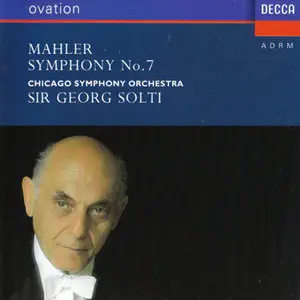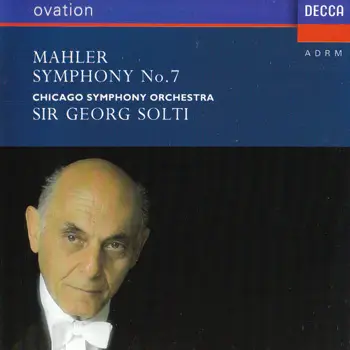Gustav Mahler: Symphony No. 7 – Chicago Symphony Orchestra, Sir Georg Solti, conductor
Classical | 1 CD | EAC Rip | 359 MB | FLAC+LOG+M3U+Cue | Full scans | 2 RS links
Publisher: Decca
In one important respect this recording of the Seventh outstrips his previous Chicago recordings of Mahler. It was made not in the reverberant Medinah Temple but in the University of Illinois, where the engineers have apparently found an outstanding recording hall. The opulent brilliance of Decca sound now does full justice to this extraordinary orchestra.
It was only last March that DC had the very difficult job of summing up the respective merits of two sets that he described as "superlative". I agree with his analysis, though on balance I would favour Haitink more than he did, if only for the negative reason that Bernstein's close-up sound worries me. True, it suits the highly coloured Bernstein reading very well, but many delicate moments are coarsened and the fantasy undermined. Bernstein's reading of the second Nachtmusik is sensuously beautiful, but it would be even more so, were there a true pianissimo. By contrast Haitink gains from the refinement of the Philips recording, and I was surprised that as well as freshness, he has a vein of pointed fantasy, a twinkle in the eye. He grips one's imagination not just by his direct sterling qualities, but by lightness of imagination too.
When one relates Solti's interpretation to the other two—I leave out Klemperer as being too heavily idiosyncratic in this instance—at least there are some tempo contrasts to underline. The opening Adagio is here much faster. Where Haitink is subdued, dark, ominous, Solti even here demonstrates his energy. After the other two you may find funeral march rhythms too fast at this tempo, but there is no denying the compulsion, the urgency, and even in principle there is an argument for integrating this material more closely than is common with the main Allegro. In that main tempo of the movement Solti is reasonably close to the other two, and in the carefully marked variations of tempo in the big second subject melody Solti is closer to Haitink in not playing it all for extrovert passion.
Here and throughout the performance the Chicago violins outshine not only those in the New York orchestra but even those in the Concertgebouw. The playing in all three sets is very fine indeed, but Chicago on balance leads the way. The horn passage at the opening of the second movement is more flamboyant than with either of the other two, more commanding. Yet later Solti finds a mercurial quality in the music, helped by the delicacy of playing. He even manages to make his very fast tempo for the third movement sound natural and unrushed, again mercurial in its lightness. In the fourth movement, the unforgettable second Nachtmusik, Solti favours a similar slower tempo to Bernstein's against Haitink's folk-like manner. He rivals Bernstein too in his warmly affectionate phrasing, and gains from the refinement of recording quality. In the finale Solti sets an even more hectic tempo at the start, pushing on with such momentum that the fermata just after fig. 229 makes a physical assault on the senses not dissimilar to a sudden stop in a car. The impact is perfectly legitimate, and though later he misses some of Haitink's fantasy and Bernstein's exuberance, the dynamism is compelling to the end. Predictably he does not draw out the reminiscence of the second Nachtmusik phrase near the end as much as his rivals.
Choice between the three must be a very personal one. With superlative recording quality Solti's will be a natural first choice for many, particularly when his dynamism is never screwed impossibly far, as it has sometimes been in the past. The delicacy of the second Nachtmusik too is a point in favour. I myself veer between this and the Haitink. It is particularly difficult to know what will be best not just for a single playing, but for a performance to live with. At least it is good that the gramophone can provide us with such admirably contrasted interpretations even in what was once the most neglected of the Mahler symphonies.
E.G. Gramopone, September 1971
Exact Audio Copy V0.99 prebeta 4 from 23. January 2008
EAC extraction logfile from 2. September 2009, 14:40
Gustav Mahler.: Symphonie Nr. 7 / Sir Georg Solti & Chicago Symphony Orchestra
Used drive : HL-DT-STDVDRAM GSA-4167B Adapter: 3 ID: 0
Read mode : Secure
Utilize accurate stream : Yes
Defeat audio cache : No
Make use of C2 pointers : No
Read offset correction : 667
Overread into Lead-In and Lead-Out : No
Fill up missing offset samples with silence : No
Delete leading and trailing silent blocks : No
Null samples used in CRC calculations : No
Used interface : Native Win32 interface for Win NT & 2000
Used output format : User Defined Encoder
Selected bitrate : 320 kBit/s
Quality : High
Add ID3 tag : No
Command line compressor : C:\Program Files\Exact Audio Copy\FLAC\FLAC.EXE
Additional command line options : -6 -V -T "ARTIST=%a" -T "TITLE=%t" -T "ALBUM=%g" -T "DATE=%y" -T "TRACKNUMBER=%n" -T "GENRE=%m" -T "COMMENT=%e" %s -o %d
TOC of the extracted CD
Track | Start | Length | Start sector | End sector
––––––––––––––––––––––––––––-
1 | 0:00.32 | 21:39.55 | 32 | 97511
2 | 21:40.12 | 15:49.43 | 97512 | 168729
3 | 37:29.55 | 9:19.15 | 168730 | 210669
4 | 46:48.70 | 14:31.00 | 210670 | 275994
5 | 61:19.70 | 16:27.35 | 275995 | 350054
Range status and errors
Selected range
Filename I:\My Documents\My Music\Mahler\Symphony No 7 - Solti\Gustav Mahler. Symphonie Nr. 7 - Sir Georg Solti & Chicago Symphony Orchestra.wav
Peak level 97.0 %
Range quality 100.0 %
Copy CRC F945DCD2
Copy OK
No errors occurred
End of status report
EAC extraction logfile from 2. September 2009, 14:40
Gustav Mahler.: Symphonie Nr. 7 / Sir Georg Solti & Chicago Symphony Orchestra
Used drive : HL-DT-STDVDRAM GSA-4167B Adapter: 3 ID: 0
Read mode : Secure
Utilize accurate stream : Yes
Defeat audio cache : No
Make use of C2 pointers : No
Read offset correction : 667
Overread into Lead-In and Lead-Out : No
Fill up missing offset samples with silence : No
Delete leading and trailing silent blocks : No
Null samples used in CRC calculations : No
Used interface : Native Win32 interface for Win NT & 2000
Used output format : User Defined Encoder
Selected bitrate : 320 kBit/s
Quality : High
Add ID3 tag : No
Command line compressor : C:\Program Files\Exact Audio Copy\FLAC\FLAC.EXE
Additional command line options : -6 -V -T "ARTIST=%a" -T "TITLE=%t" -T "ALBUM=%g" -T "DATE=%y" -T "TRACKNUMBER=%n" -T "GENRE=%m" -T "COMMENT=%e" %s -o %d
TOC of the extracted CD
Track | Start | Length | Start sector | End sector
––––––––––––––––––––––––––––-
1 | 0:00.32 | 21:39.55 | 32 | 97511
2 | 21:40.12 | 15:49.43 | 97512 | 168729
3 | 37:29.55 | 9:19.15 | 168730 | 210669
4 | 46:48.70 | 14:31.00 | 210670 | 275994
5 | 61:19.70 | 16:27.35 | 275995 | 350054
Range status and errors
Selected range
Filename I:\My Documents\My Music\Mahler\Symphony No 7 - Solti\Gustav Mahler. Symphonie Nr. 7 - Sir Georg Solti & Chicago Symphony Orchestra.wav
Peak level 97.0 %
Range quality 100.0 %
Copy CRC F945DCD2
Copy OK
No errors occurred
End of status report



